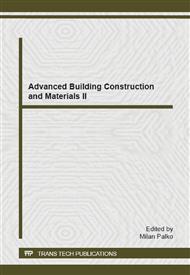[1]
F. Cappelletti et al., Analysis of the influence of installation thermal bridges on windows performance: The case of clay block walls, Energy and Buildings, 43 (2011) 1435-1442.
DOI: 10.1016/j.enbuild.2011.02.004
Google Scholar
[2]
A. Gasparella et al., Analysis and modelling of window and glazing systems energy performance for a well insulated residential building, Energy and Buildings, 43 (2011) 1030-1037.
DOI: 10.1016/j.enbuild.2010.12.032
Google Scholar
[3]
P. Baggio et al., Analysis of the thermal bridges between wall and window on energy performance of the building envelope, CLIMA 2010, 10th Rehva World Congress, Sustainable Energy Use in Buildings, Antalya (2010).
Google Scholar
[4]
D. Katunský et al., Numerical analysis and measurement results of a window sill, Advanced Materials Research, 899 (2014) 147-150.
DOI: 10.4028/www.scientific.net/amr.899.147
Google Scholar
[5]
M. Zozulák, D. Katunský, Experimental temperature measurement in the window sill, Tepelná ochrana budov, 1 (2014) 32-38.
Google Scholar
[6]
M. Zozulák, Numerical solution of window sill seating depth construction. Institute of Architectural Engineering PhD students' seminar, Košice (2014) 132-137.
Google Scholar
[7]
D. Katunský et al., Measuring methodology and results of heat-air-moisture performances at building envelope levels, Advanced Materials Research, 649 (2013) 85-88.
DOI: 10.4028/www.scientific.net/amr.649.85
Google Scholar
[8]
Standard STN 73 0540-2: Thermal protection of buildings. Thermal performance of buildings and components. Part 2: Functional requirements, July (2012).
Google Scholar
[9]
Standard STN EN ISO 13790/NA/Z1: Energy performance of buildings. Calculation of energy use for space heating and cooling, July (2012).
Google Scholar
[10]
Standard STN EN ISO 10211: Thermal bridges in building construction. Heat flows and surface temperatures. Detailed calculations, August (2008).
DOI: 10.3403/30143206u
Google Scholar
[11]
Standard STN EN ISO 14683: Thermal bridges in building construction. Simplified methods and default values, July (2008).
Google Scholar
[12]
M. Vertaľ, M. Lopušniak, Design, evaluation critical places in terms of heat-air-moisture performances and realization experiences of low energy building roof, Střechy, fasády, izolace, 11 (2009) 42-44.
Google Scholar
[13]
M. Bagoňa, C. Stone, J. Simicek, Dynamic thermal properties of uninsulated rammed earth building envelopes, Advanced Materials Research, 855 (2014) 85-88.
DOI: 10.4028/www.scientific.net/amr.855.85
Google Scholar
[14]
Physibel Software – User manual for Physibel. Maldegem, Belgium (2013) 25-26.
Google Scholar
[15]
A. Korjenic, T. Bednar, Transformation of fundamental parameters for energy demand and indoor temperature from room level to building level, Journal of Building Physics, 33 (4) (2010) 327-355.
DOI: 10.1177/1744259109358284
Google Scholar


